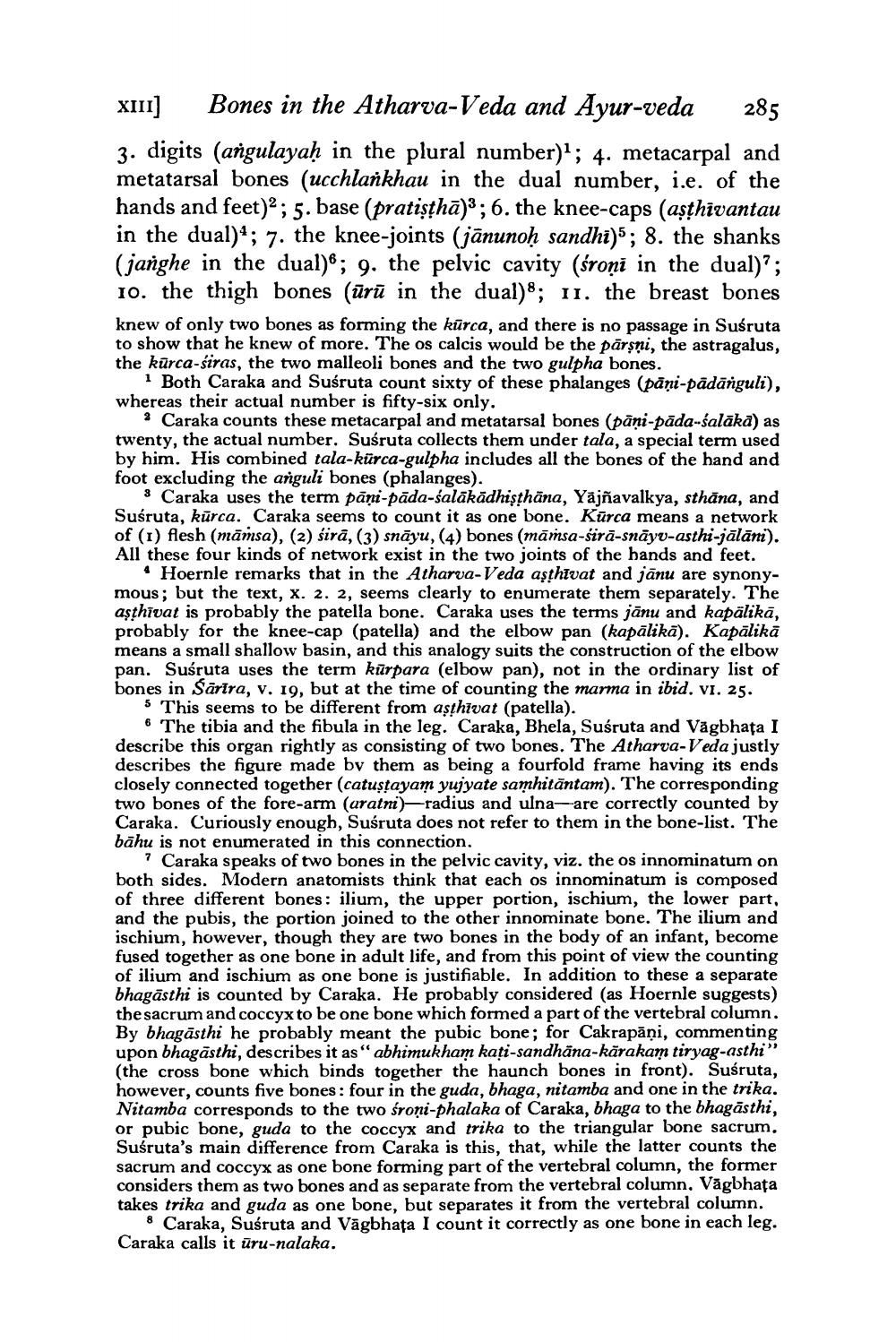________________
XIII]
Bones in the Atharva-Veda and Ayur-veda
285
3. digits (angulayah in the plural number)1; 4. metacarpal and metatarsal bones (ucchlankhau in the dual number, i.e. of the hands and feet)2; 5. base (pratiṣṭhā)3; 6. the knee-caps (aşṭhivantau in the dual); 7. the knee-joints (jānunoḥ sandhi)5; 8. the shanks (janghe in the dual)6; 9. the pelvic cavity (śroni in the dual)"; 10. the thigh bones (ūru in the dual); 11. the breast bones knew of only two bones as forming the kurca, and there is no passage in Suśruta to show that he knew of more. The os calcis would be the pārsni, the astragalus, the kurca-siras, the two malleoli bones and the two gulpha bones.
1 Both Caraka and Suśruta count sixty of these phalanges (pāņi-pādānguli), whereas their actual number is fifty-six only.
2 Caraka counts these metacarpal and metatarsal bones (pāņi-pada-salākā) as twenty, the actual number. Suśruta collects them under tala, a special term used by him. His combined tala-kürca-gulpha includes all the bones of the hand and foot excluding the anguli bones (phalanges).
3 Caraka uses the term pāņi-pada-salākādhiṣṭhāna, Yājñavalkya, sthāna, and Suśruta, kurca. Caraka seems to count it as one bone. Kurca means a network of (1) flesh (māṁsa), (2) śirā, (3) snāyu, (4) bones (māmsa-sirā-snāyv-asthi-jālāni). All these four kinds of network exist in the two joints of the hands and feet.
4 Hoernle remarks that in the Atharva-Veda aşṭhivat and jānu are synonymous; but the text, X. 2. 2, seems clearly to enumerate them separately. The aşthivat is probably the patella bone. Caraka uses the terms jānu and kapälikā, probably for the knee-cap (patella) and the elbow pan (kapālikā). Kapālikā means a small shallow basin, and this analogy suits the construction of the elbow pan. Suśruta uses the term kurpara (elbow pan), not in the ordinary list of bones in Sarira, v. 19, but at the time of counting the marma in ibid. VI. 25.
5 This seems to be different from aşthivat (patella).
6 The tibia and the fibula in the leg. Caraka, Bhela, Suśruta and Vagbhata I describe this organ rightly as consisting of two bones. The Atharva-Veda justly describes the figure made by them as being a fourfold frame having its ends closely connected together (catuṣṭayam yujyate samhitantam). The corresponding two bones of the fore-arm (aratm)-radius and ulna-are correctly counted by Caraka. Curiously enough, Suśruta does not refer to them in the bone-list. The bāhu is not enumerated in this connection.
7 Caraka speaks of two bones in the pelvic cavity, viz. the os innominatum on both sides. Modern anatomists think that each os innominatum is composed of three different bones: ilium, the upper portion, ischium, the lower part, and the pubis, the portion joined to the other innominate bone. The ilium and ischium, however, though they are two bones in the body of an infant, become fused together as one bone in adult life, and from this point of view the counting of ilium and ischium as one bone is justifiable. In addition to these a separate bhagasthi is counted by Caraka. He probably considered (as Hoernle suggests) the sacrum and coccyx to be one bone which formed a part of the vertebral column. By bhagasthi he probably meant the pubic bone; for Cakrapāņi, commenting upon bhagästhi, describes it as" abhimukham kați-sandhäna-kärakam tiryag-asthi" (the cross bone which binds together the haunch bones in front). Suśruta, however, counts five bones: four in the guda, bhaga, nitamba and one in the trika. Nitamba corresponds to the two śroni-phalaka of Caraka, bhaga to the bhagästhi, or pubic bone, guda to the coccyx and trika to the triangular bone sacrum. Suśruta's main difference from Caraka is this, that, while the latter counts the sacrum and coccyx as one bone forming part of the vertebral column, the former considers them as two bones and as separate from the vertebral column. Vägbhata takes trika and guda as one bone, but separates it from the vertebral column.
8 Caraka, Suśruta and Vagbhața I count it correctly as one bone in each leg. Caraka calls it uru-nalaka.




